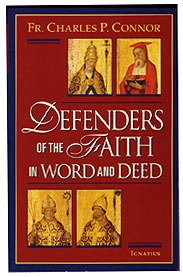Often persecuted, sometimes martyred, and accused of incest, cannibalism, "atheism"
On this, the Feast of the First Martyrs of the Church of Rome, some historical background from "Early Christian Martyrs of the Roman Empire", the opening chapter of Fr. Charles P. Connor's Defenders of the Faith in Word and Deed (Ignatius Press, 2003):
It is true that Christians lived in a somewhat tense atmosphere for the first three centuries of the Church's life. It is not true that persecution was unceasing; rather, it was intermittent, sometimes limited to the city of Rome, sometimes  extending throughout the Empire. A popular legend evolved through the centuries about when anti-Christian hostility became intense, believers would hide from Roman officials in the catacombs, underground burial places on the outskirts of the city. These were not secret hiding places; in fact, they were well marked on city maps. It so happened that the soft turf of the region could be easily excavated and developed into a large network of subterranean tunnels, which could be utilized for several purposes, burial among them. Christians (and, for that matter, Jews as well) found the system of underground burial ideal in a city where space was at a premium. In addition, the catacombs provided a space for gathering for the celebration of the Holy Eucharist and for Christian artists to leave for posterity a fascinating record of a vibrant faith.
extending throughout the Empire. A popular legend evolved through the centuries about when anti-Christian hostility became intense, believers would hide from Roman officials in the catacombs, underground burial places on the outskirts of the city. These were not secret hiding places; in fact, they were well marked on city maps. It so happened that the soft turf of the region could be easily excavated and developed into a large network of subterranean tunnels, which could be utilized for several purposes, burial among them. Christians (and, for that matter, Jews as well) found the system of underground burial ideal in a city where space was at a premium. In addition, the catacombs provided a space for gathering for the celebration of the Holy Eucharist and for Christian artists to leave for posterity a fascinating record of a vibrant faith.
This is not to minimize persecutions. They occurred with ferocity, and many martyrs and defenders of the faith came forth. They were martyrs because they died under some excruciating form of torture; they were defenders of the faith because of their witness to Christ as their only Lord, to the exclusion of all others, including the emperor. We know of their persecutions and martyrdoms from three principal sources: the accounts of non-Christian historians, the minutes of their trials (known as the Acts of the Martyrs), and eyewitness accounts.
The earliest persecutions seemed to have occurred under the Emperor Nero (54- 68) and may well have been an attempt to turn the attention of Rome's citizens away from the Emperor's own burning of the city. It was a persecution limited to Rome itself, and both Peter and Paul are believed to have been victims of it. Tacitus, a Roman historian, pictures it vividly:
First, then, the confessed members of the sect were arrested; next, on their disclosures, vast numbers were convicted, not so much on the count of arson as for hatred of the human race. And derision accompanied their end: they were covered with wild beasts' skins and torn to death by dogs; or they were fastened on crosses, and, when daylight failed, were burned to serve as lamps by night. Nero had offered his gardens for the spectacle, and gave an exhibition in his circus, mixing with the crowd in the habit of a charioteer, or mounted on his car. Hence, in spite of a guilt which had earned the most exemplary punishment, there arose a sentiment of pity, due to the impression that they were being sacrificed not for the welfare of the state but to the ferocity of a single man. [Tacitus, Annals, bk. 15, chap. 44]
"Incest" and "cannibalism" are hardly terms to be thrown about lightly. They were, however, among the most common accusations made against Christians. Even more curious was the charge of atheism. It was assumed that since Christians did not practice the religion of the state, the worship of the pagan gods, that they had no religion. If this persisted, the gods would become angry and inflict all sorts of wrath on Roman society.
Related Ignatius Insight Excerpts and Articles:
• Studying The Early Christians: The Introduction to We Look For the Kingdom | Carl J. Sommer
• The Everyday Lives of the Early Christians | An interview with Carl J. Sommers
• Church and State in Early Christianity | Hugo Rahner, S.J.
• His Story and the History of the Church | An Interview with Dr. Glenn W. Olsen
• Are We at The End or The Beginning? | Dr. Glenn Olson
• A Short Guide to Ancient Heresies | Kenneth D. Whitehead
Carl E. Olson's Blog
- Carl E. Olson's profile
- 20 followers



